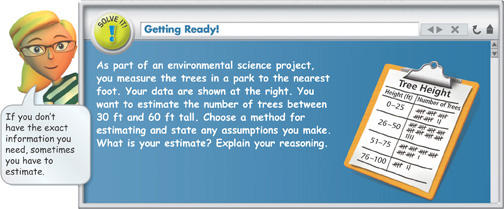12-2 Frequency and Histograms
Objective
To make and interpret frequency tables and histograms
 Lesson Vocabulary
Lesson Vocabulary
- frequency
- frequency table
- histogram
- cumulative frequency table
Essential Understanding There are many ways to organize and visually display data. Sometimes it is helpful to organize numerical data into intervals.
The frequency of an interval is the number of data values in that interval. A frequency table groups a set of data values into intervals and shows the frequency for each interval. Intervals in frequency tables do not overlap, do not have any gaps, and are usually of equal size.
 Problem 1 Making a Frequency Table
Problem 1 Making a Frequency Table
Baseball The numbers of home runs by the batters in a local home run derby are listed below. What is a frequency table that represents the data?
7 17 14 2 7 9 5 12 3 10 4 12 7 15
The minimum data value is 2 and the maximum is 17. Intervals of 4 seem reasonable. In the first column of the table, list the intervals. Count the number of data values in each interval and list the number in the second column.
Plan
How do you choose intervals?
The data values range from 2 to 17, so there are a total of 16 possible values. You can divide these 16 values into 4 intervals of size 4.
| Home Runs | Frequency |
|---|---|
| 2–5 | 4 |
| 6–9 | 4 |
| 10–13 | 3 |
| 14–17 | 3 |
✓ Got It?
- What is a frequency table for the data in Problem 1 that uses intervals of 5?
Table of Contents
- 2-1 and 2-2 Solving One- and Two-Step Equations
- 2-3 Solving Multi-Step Equations
- 2-4 Solving Equations With Variables on Both Sides
- 2-5 Literal Equations and Formulas
- 2-6 Ratios, Rates, and Conversions
- 2-7 and 2-8 Solving Proportions and Using Similar Figures
- 2-9 Percents
- 2-10 Change Expressed as a Percent
- 3-1 Inequalities and Their Graphs
- 3-2 Solving Inequalities Using Addition or Subtraction
- 3-3 Solving Inequalities Using Multiplication or Division
- 3-4 Solving Multi-Step Inequalities
- 3-5 Working With Sets
- 3-6 Compound Inequalities
- 3-7 Absolute Value Equations and Inequalities
- 3-8 Unions and Intersections of Sets
- Chapter 1 Foundations for Algebra
- Chapter 2 Solving Equations
- Chapter 3 Solving Inequalities
- Chapter 4 An Introduction to Functions
- Chapter 5 Linear Functions
- Chapter 6 Systems of Equations and Inequalities
- Chapter 7 Exponents and Exponential Functions
- Chapter 8 Polynomials and Factoring
- Chapter 9 Quadratic Functions and Equations
- Chapter 10 Radical Expressions and Equations
- Chapter 11 Rational Expressions and Functions
- Chapter 12 Data Analysis and Probability





